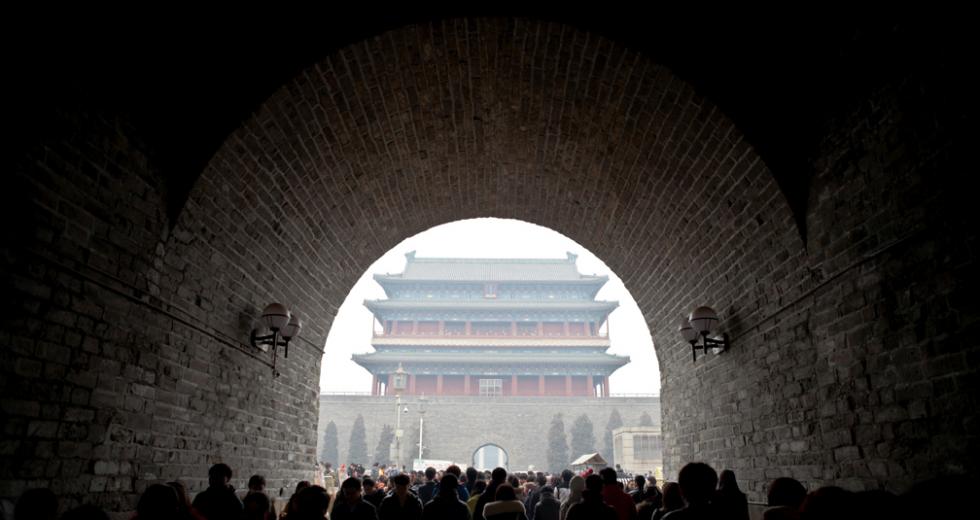Terry Green was sitting at home a few years ago when his cell phone rang.
Would his company be interested in doing some projects in China?
Green, a principal at Williams + Paddon Architects + Planners Inc. in Roseville, didn’t know what to make of it. The man on the phone spoke broken English. “It was hard for me to know how to communicate,” Green says. “I didn’t know how slow to speak or how simple I should keep my sentences.”
Two weeks prior to the call, Green’s firm had won an international award for a golf clubhouse in the San Luis Obispo area. Now, it slowly emerged, the award had caught the eye of someone 6,000 miles away.
The caller from China had great timing.
It was a lousy time to be an architect in Northern California. The American Institute of Architecture’s Central Valley chapter estimated that unemployment among local architects in 2010 was nearly 25 percent.
China, on the other hand, was booming. The communist government might still insist that China’s 1.3 billion people tow the line politically, but economically most barriers had come down. In fact, the country is a huge, growing market for golf resorts and recreational facilities, Green soon learned.
“There is a big surge in all the Asian countries for golf. They are hiring top-notch American golf course designers,” he says. “Plus, there is a big, growing middle income level there. A lot of these people are buying vacation homes out in the country, and usually they are centered on golf courses.”
China has the means to build, but it likes to import the creative aspects, he says.
Williams + Paddon had bumped into a big market that is growing fast. China may still be a Communist nation politically, but economically it has loosened the reins on free-market forces. According to the U.S. Commerce Department, China’s leadership aims to increase consumption activity from approximately 35 percent of gross domestic product in 2010 to 50 percent by 2015.
“China’s rapid economic growth, especially in the urban areas, has led to a booming consumer market for high-end goods and services, including tourism and education. China will account for the consumption of about 20 percent of global luxury goods by 2015, or $27 billion,” a Commerce Department report says. China now has a middle class economy, and by 2020, it is expected to account for around 45 percent of the population, or about 700 million people.
But Williams + Paddon also recognized that, with only 24 architects in the firm, it didn’t have a lot of resources to draw on for a push into China. No one in the firm spoke Mandarin. No one was familiar with Chinese business protocol. No one knew what the Communist government would and wouldn’t allow them to do.
“You need to know that you have the staff capacity to do it right, that you have the production capacity,” says Renee Taylor, CEO of the World Trade Center Northern California. “Then you really need an executive team commitment.”
Every business is going to have its own checklist for deciding whether to take the plunge, she says. Designing buildings is a different venture than exporting furniture, which is different than exporting software.
“Many people who call us are looking for Export 101,” Taylor says. Her organization offers webinars, seminars and in-person workshops to cover the basics.
Companies already producing and distributing products may not need the introductory course, but they do need to look at their logistics, she says. How will you ship the product? Are you used to working with customs brokers? Are you working with a heavily regulated product such as food?
The Commerce Department offers help through its U.S. Commercial Service in China. It has trade specialists in various regions of the country, including the U.S. Embassy in Beijing and consulates in Shanghai, Guangzhou, Chengdu and Shenyang. It also provides detailed market information by industry sector. It even has an Export Assistance Center right here in Sacramento. Director George Tastard warns that China is not a “starter country,” but stands ready to walk exporters through the basics:
• Does the U.S. company already have a freight forwarder lined up? If not, get ready to take a crash course in labeling requirements and other documentation. Crates need to be inspected for pests, too, Tastard says.
• Do you have a bank that can support deals in China? Small banks may not have the expertise. A big bank may have the experts, but they’re sitting in San Francisco and might not want to bother with a deal of less than $400,000. Also, look for import/export bank insurance to underwrite the receivables and mitigate political and economic risk. The insurance makes the bank more inclined to loan money on the receivables and ease an exporter’s cash flow, Tastard says. Ocean shipping will take a couple of weeks just to get the product from shore to shore, so don’t expect invoices to get paid in 30 days.
Companies that haven’t done international trade before might be better off starting with Canada or Mexico, Tastard says.
Still, China may offer opportunities that can’t be matched in nearby countries. Just be aware that it’s one of the hardest markets to crack, says attorney Scott Bartel, a partner at Locke Lord in Sacramento.
First, there’s the cultural barrier, starting with the language. Unlike Europe and parts of South America where English is predominantly the language of business, China sticks to Mandarin.
“Many owners of Chinese businesses right now speak no English,” Bartel says. It’s important, then, to make sure business decisions don’t get lost in translation.
“There is a very formidable barrier in getting agreements done, where both parties are agreeing to the same thing,” he says.
Williams + Paddon started its Chinese sojourn by relying on the man who originally called Green. The caller turned out to be an agent, a go-between who offered to line up companies to pitch.
As Green knew from the first call, the agent’s English wasn’t the greatest. But more importantly, he didn’t know the architecture field that well. When Williams + Paddon eventually did land a client, the client hinted that something better was needed. Green ended up hiring an intern, Yingxi Chen, who grew up in Beijing and now works out of the Roseville office.
Chen turned out to be helpful on other cultural aspects when she and Green traveled to China for meetings with potential clients. As one meeting wrapped up, Green started walking through the door before the client. “She grabbed my jacket and pulled me back,” Green says. The big boss always leaves a space first. Everyone else follows.
China’s culture is still changing. Many industries are dominated by businesses that are either state owned or used to be. The owners grew up in an economy planned out by the Communist government.
“As they transition into capitalism, the older owners are not as familiar with the way of doing business in the West,” Bartel says. Some are still grasping the nuances of the freedom to contract and the importance of contracts.
Until the mid-1990s, the main accounting system in China was based on production and output, with no concept of profit, Bartel says.
“You really have an oil-and-vinegar type of situation, where you are trying to get to an agreement of business terms, and the owner on the other side maybe isn’t sensitive to the issues that drive a U.S. business,” he says.
The Chinese government may have relaxed its grip on commerce, but it’s tightly regulated compared to what American companies are used to. Certain sectors of the Chinese economy are off limits to foreign ownership altogether. In other sectors, the government requires that foreign companies partner with one in China. Still, other sectors have no restrictions.
“If you were to attempt to engage in commerce in the Chinese economy, you would have to establish a wholly foreign-owned enterprise,” Bartel said. The WFOE — called a “woofy” — has to be established and capitalized in China and has to file paperwork with both the national and provincial governments.
“That requires the small business to engage counsel to guide them through that process,” Bartel says. His firm can do that but normally works with a local Chinese counsel to help with the filings.
Companies that want to rush into the Chinese market also must get used to the idea that there is no such thing as rushing into the Chinese market. A small business shouldn’t try unless it can afford to invest the time.
It took Williams + Paddon a year just to start meeting clients. All that time had been taken up with having brochures translated into Mandarin and other back-and-forth communications with the agent.
Finally it was time to meet in person with prospects. The agent said to send the executive with the grayest hair and the least amount of it. Being older and distinguished makes it look like you know what you are talking about, he said. As a Williams + Paddon principal, Terry Green was lucky to also be balding and gray. Fortunately for the company, he’s also the principal specializing in hospitality projects.
“It is really important to them to have a senior person do the presentation,” he says.
The small-business exec should be ready for some grueling travel. Green goes once a month for a week. That’s about 12 hours of flying each way, plus a few days on each end to shake off the jet lag.
And then there are the dinners.
“Everything was done around the dinner table,” Green says. They talked about who Green was, who their developers were, their respective families and other things before the first mention of work.
“I think I learned more about these people than I did with my clients in my own country,” he says.
All of this, of course, had to be done through a translator.
“I think the younger entrepreneurs take less time. But the fact is that unless you are physically present, it is difficult,” says attorney Bartel. “The distance requires that you get on airplanes and get over there. This is all a cost-benefit model, so is the opportunity in the Chinese economy big enough to go through that?”
The upside potential was mind-blowing. Green declined to name his first big client, but said the man runs a company with a couple hundred thousand employees and has a cultural status of a Chinese Bill Gates.
And there was Green having dinner at the man’s house.
Before long, Williams + Paddon had two clients with nine projects between them: two resort projects, some golf clubhouses, a couple of little teahouses and some remodels of banquet facilities.
One big plus for Williams + Paddon was its ability to charge more than normal for its China work. The trick is getting paid. Again, a company has to have deep enough pockets to be patient.
“There is a whole process they have to go through with the government, and that takes a few weeks,” Green says. The culture is to bill by phase of work rather than monthly. That can mean working for two or three months before submitting a bill and waiting another two or three months to get the money.
Some small businesses might be tempted to buy off key people in order to speed things up. There is a layer of corruption in China that has been recognized by its government, but hasn’t yet been thoroughly cleaned up, Bartel says. Be aware that the U.S. Foreign Corrupt Practices Act is very much in force.
“There is a layer of corruption in China that has been recognized by the government and is being attempted to clean up. But it is a trap for the unwary,” he says.
For Williams + Paddon, responding to the original cell phone call was a roll of the dice, says Green. But by doing some due diligence and being patient, it has paid off.
“Basically I told my partners, ‘You tell me where to turn the volume knob.’ Because, if I wanted to, I could get the whole office busy.”
Recommended For You

Where is Margaret Wong now?
Then:
We introduced Margaret Wong, president of West Sacramento-based McWong International, to our readership as part of Comstock’s international business special section in February of ‘97.

World Travel
Can Sacramento cash in on an influx of Chinese tourism dollars?
Two hundred million Chinese tourists will pack their bags and depart their homeland in 2020, bound for destinations across the globe. It’s not a mass exodus; they’re not fleeing their government. They’re tourists, and, according to CNN, they might be the greatest phenomenon to hit the global travel industry since the invention of commercial flight.




